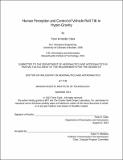Human perception and control of vehicle roll tilt in hyper-gravity
Author(s)
Clark, Torin Kristofer
DownloadFull printable version (7.082Mb)
Other Contributors
Massachusetts Institute of Technology. Department of Aeronautics and Astronautics.
Advisor
Torin K. Clark.
Terms of use
Metadata
Show full item recordAbstract
Pilots and astronauts experience a range of altered gravity environments in which they must maintain accurate perception and control of vehicle orientation for tasks such as landing and docking. To study sensorimotor function in altered gravity, a hyper-gravity test-bed was produced using a centrifuge. Previous experiments have quantified static tilt perception in hyper-gravity; however, studies of dynamic tilt, such as those experienced by astronauts and pilots, have been entirely qualitative. Current dynamic models of orientation perception cannot reproduce the characteristic perceptions observed in hyper-gravity. The aims of this thesis are to: 1) quantify static and dynamic roll tilt perception in hyper-gravity, 2) study pilot manual control of vehicle roll tilt in hyper-gravity, and 3) modify a dynamic model to predict hyper-gravity orientation perception. A long-radius centrifuge was utilized to create hyper-gravity environments of 1.5 and 2 Earth G's. In one experiment, over a range of roll tilt angles and frequencies, human subjects' (N=8) perceptions of orientation, in the dark, were assayed with a somatosensory task. Static roll tilts were overestimated in hyper-gravity with more overestimation at higher gravity levels and larger roll angles. Dynamic rotations were also overestimated in hyper-gravity, but generally less so than for static tilts. The amount of overestimation during dynamic rotations was dependent upon the angular velocity of the rotation with less overestimation at higher angular velocities. In a second experiment, human subjects (N=12) were tasked with nulling a pseudo-random vehicle roll disturbance using a rotational hand controller. Initial nulling performance was significantly worse in hyper-gravity as compared to the 1 G performance baseline. However, hyper-gravity performance improved with practice, reaching near the 1 G baseline over the time course of several minutes. Finally, pre-exposure to one hyper-gravity level reduced the measured initial performance decrement in a subsequent, different hyper-gravity environment. A modification to a previous dynamic spatial orientation perception model was proposed to allow for the prediction of roll tilt overestimation observed in hyper-gravity. It was hypothesized that the central nervous system treats otolith signals in the utricular plane differently from those out of plane. This was implemented in the model by setting a difference between the linear acceleration feedback gains in and out of the utricular plane. The modified model was simulated and found to accurately predict the static overestimation observed over a wide range of angles and hyper-gravity levels. Furthermore, it simulated the characteristic dependence of dynamic overestimation upon angular velocity with less overestimation at higher angular velocities. The modified model now allows for simulation across a range of altered gravity environments to predict human orientation perception. We conclude that hyper-gravity results in misperception of static and dynamic roll tilt and decrements in pilot manual control performance. Perception and manual control errors due to altered gravity, such as those observed here in hyper-gravity, may impact the safety of future crewed space exploration missions, in terms of accidents or aborts.
Description
Thesis: Ph. D., Massachusetts Institute of Technology, Department of Aeronautics and Astronautics, 2013. This electronic version was submitted by the student author. The certified thesis is available in the Institute Archives and Special Collections. Cataloged from student-submitted PDF version of thesis. Includes bibliographical references (pages 96-105).
Date issued
2013Department
Massachusetts Institute of Technology. Department of Aeronautics and AstronauticsPublisher
Massachusetts Institute of Technology
Keywords
Aeronautics and Astronautics.